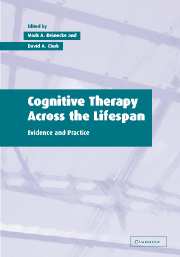Book contents
- Frontmatter
- Contents
- List of contributors
- Foreword
- 1 Cognitive therapy across the lifespan: conceptual horizons
- 2 Cognitive theory and therapy of depression
- 3 Cognitive theory and therapy of bipolar disorders
- 4 Regulation of emotion in generalized anxiety disorder
- 5 Cognitive theory and therapy of obsessions and compulsions
- 6 The cognitive model of panic
- 7 Treating obsessional problems using cognitive-behavioral therapy
- 8 Narcissistic personality disorder
- 9 Cognitive therapy and the self
- 10 Promoting cognitive change in posttraumatic stress disorder
- 11 Cognitive theory and therapy of social phobia
- 12 The cognitive model of bulimia nervosa
- 13 Cognitive therapy and schizophrenia
- 14 Cognitive-behavioral interventions for alcohol abuse and dependence
- 15 Cognitive approaches to understanding, preventing and treating child and adolescent depression
- 16 Cognitive-behavioral interventions in childhood anxiety disorders
- 17 Attention deficit/hyperactivity disorder
- 18 Cognitive-behavioral interventions for children with conduct problems
- 19 Processes of change in cognitive therapy
- 20 Cognitive therapy in the twenty-first century: current status and future directions
- Index
15 - Cognitive approaches to understanding, preventing and treating child and adolescent depression
Published online by Cambridge University Press: 05 July 2014
- Frontmatter
- Contents
- List of contributors
- Foreword
- 1 Cognitive therapy across the lifespan: conceptual horizons
- 2 Cognitive theory and therapy of depression
- 3 Cognitive theory and therapy of bipolar disorders
- 4 Regulation of emotion in generalized anxiety disorder
- 5 Cognitive theory and therapy of obsessions and compulsions
- 6 The cognitive model of panic
- 7 Treating obsessional problems using cognitive-behavioral therapy
- 8 Narcissistic personality disorder
- 9 Cognitive therapy and the self
- 10 Promoting cognitive change in posttraumatic stress disorder
- 11 Cognitive theory and therapy of social phobia
- 12 The cognitive model of bulimia nervosa
- 13 Cognitive therapy and schizophrenia
- 14 Cognitive-behavioral interventions for alcohol abuse and dependence
- 15 Cognitive approaches to understanding, preventing and treating child and adolescent depression
- 16 Cognitive-behavioral interventions in childhood anxiety disorders
- 17 Attention deficit/hyperactivity disorder
- 18 Cognitive-behavioral interventions for children with conduct problems
- 19 Processes of change in cognitive therapy
- 20 Cognitive therapy in the twenty-first century: current status and future directions
- Index
Summary
Depression is a significant problem among children and adolescents, with 2-5% of the population meeting diagnostic criteria for this disorder at any point in time (Fleming and Offord, 1990; Lewinsohn et al., 1993; Boyd et al., 2000). The percentage of young people affected by disorders of mood is even higher if one includes dysthymia and bipolar spectrum disorder or if we consider those who report symptoms of dysphoria but who do not meet criteria for the full clinical syndrome. The prevalence of clinical depression increases with age, being less common in preschool and primary (elementary) schoolchildren, and increasing in midadolescence. Community prevalence rates for affective disorders among schoolchildren are relatively low, ranging from 0.4% to 2.5% (Anderson et al., 1897; Kashani and Ray, 1983; Costello et al., 1988; Kashani et al., 1989). Depression is more common, however, among adolescents, with community prevalence rates ranging from 2.9% to 8% (Kashani et al., 1987; Lewinsohn et al., 1993). By the age of 18 years approximately 20% of young people will have experienced at least one episode of a depressive disorder. Moreover, 1-6% of adolescents manifest a depressive disorder at any given time (Fleming and Offord, 1990; McCracken, 1992).
In addition to the relatively high prevalence of clinical depression in young people, there are several reasons we need to take this problem seriously. First, there are a range of short-term negative consequences associated with depression, including disruption to personal relationships and school performance (Kellam et al., 1991; Petersen et al., 1993).
- Type
- Chapter
- Information
- Cognitive Therapy across the LifespanEvidence and Practice, pp. 358 - 395Publisher: Cambridge University PressPrint publication year: 2003
- 6
- Cited by



